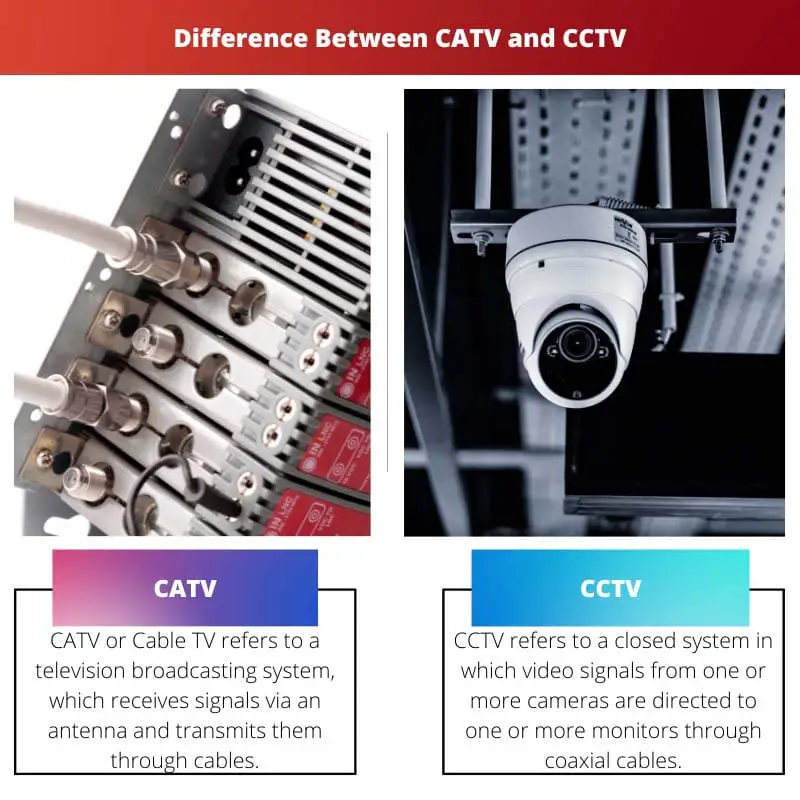Television, commonly dubbed as TV refers to the electronic relaying of video and audio from a source to a receiver. TV technology is being wielded in a variety of ways in contemporary times.
CATV and CCTV are two such systems that make use of TV technology for varying purposes.
Key Takeaways
- CATV (Community Antenna Television) delivers television programming through coaxial or fiber-optic cables. At the same time, CCTV (Closed-Circuit Television) is a surveillance system that transmits video feeds to a limited set of monitors.
- CATV is used for entertainment, whereas CCTV is primarily for security and monitoring.
- CATV signals are broadcast to multiple subscribers, while CCTV signals are restricted to a specific network and location.
CATV vs CCTV
The difference between CATV and CCTV is that CATV is a television signal distribution system, in which signals are received using an antenna but are transmitted using cables; whereas CCTV refers to a system of transmission of video signals from cameras to monitors, mostly utilized for the purposes of surveillance.

CATV or Cable TV system is a means for delivering television programming, received employing an antenna; through radio frequency signals or light pulses using cables. These cables can be coaxial or fiber-optic.
This is distinct from terrestrial television which transmits signals over the air. CATV is used in high speed telephone and internet services, apart from usage in areas where direct transmission is not possible.
CCTV, a.k.a. Video Surveillance, entails the use of video cameras for the conveyance of signals to some specific monitors using coax cables, though it can also use wireless or mesh wired links. The term is associated with cameras installed for monitoring in sensitive areas and situations, and is seldom used for videoconferencing.
Comparison Table
| Parameters of Comparison | CATV | CCTV |
|---|---|---|
| Full-Form | CATV stands for Community Antenna Television or Community Access Television. In common parlance, it refers to Cable TV. | CCTV stands for Closed Circuit Television. |
| Meaning | CATV or Cable TV refers to a television broadcasting system, which receives signals via an antenna and transmits them through cables. | CCTV refers to a closed system in which video signals from one or more cameras are directed to one or more monitors through coaxial cables. |
| Nature of transmission | A CATV cable should have high- frequency noise rejection capacity. | A CCTV cable can work with a low-frequency noise rejection capacity. |
| Cables Used | CATV broadband uses a foamed FEP (fluorinated ethylene propylene) or foamed polyethylene dielectric cable. RG6 is the standard CATV cable. | CCTV broadband uses cables having solid copper as their central conductor. RG59 coax cable is the most preferred for CCTV. |
| Type of Shielding | CATV cables should have a foil-shield. | CCTV cables should have a braided-shield. |
| Scope | CATV has a wider scope and can cover localities. | CCTV is a closed system restricted to a building. |
| Uses | CATV is used for television broadcasting systems in areas where direct transmission of broadcasting signals is difficult or impossible. Besides it can be used for high-speed internet and telephone services. | CCTV is used for surveillance purposes in areas, which require constant monitoring and additional security like hospitals, police stations, shops, etc. |
What is CATV?
Community Access Television or Community Antenna Television, i.e. CATV is a television distribution system, which involves a network of cables for relaying signals received through antennas. It is the most common method for providing cabling services to customers.
Multiple channels are distributed to the cable subscribers through a network of coaxial wires, which is operational either underground or overhead in a local setting, from the headend. A CATV network requires high-frequency noise rejection transmission and therefore uses foil-shielded wires that minimize coupled noises from other sources.
CATV broadband works with foamed FEP dielectric cables that can handle the vast multitude of channels. RG6 is the most widely used CATV cable in modern times.
Cable TV emerged as a commercial business in 1950 in the United States. Initially, cable systems served in areas without their TV stations.
However, in the contemporary era of broadcast television with over-the-air transmission, they serve in areas where these cannot work.
Since coaxial cables are equipped with bi-directional carriage of signals and relaying of huge amounts of data, the CATV system is increasingly being utilized for other digital services like cable telephony, cable internet, and wireless services. Broadband internet access is materialized over the CATV system.
What is CCTV?
Closed Circuit Television or CCTV stands for a closed network in which cables transmit video signals obtained from cameras to monitors at a specific place. Modern CCTVs use a variety of cables, ranging from coaxial wires to wireless or meshed wires.
A typical CCTV network comprises cameras with an image-sensor lens that captures video signals, a recorder that keeps them, cables that are used for transmission, and a limited number of monitors to which the signals are transmitted. CCTV networks require low-frequency sound rejection and hence work with braid-shielded copper-based cables.
While RG59 is the standard cable for analog CCTV networks, the type of camera used varies according to its purpose. CCTV systems with large storage capacity are also developing these days.
The earliest manually-operated CCTV system was developed in Stalinist Russia in 1927, followed by similar developments in other authoritarian regimes like Nazi Germany. It was initially introduced for use in monitoring, while later it was also used for broadcasting sports like boxing and wrestling.
These days it is widely used in surveillance, for crime-solving, malls and retail stores, traffic flow monitoring, increasing safety at public places, monitoring employees, etc. Besides its public use, these systems are installed in private households too.

Main Differences Between CATV and CCTV
- While, CATV is a television broadcasting system that accepts signals via an antenna, but transmits it through coax cables; CCTV is a system in which video signals are transmitted to a fixed number of monitors.
- A CATV cable should have high-frequency noise rejection capability because it broadcasts TV and thus uses a foil-shield. CCTV cables, on the other hand, can manage with low-frequency noise rejection and thus have braided-shield.
- CATV broadband utilizes foamed polyethylene or foamed FEP dielectric cables, while CCTV broadband employs cables with solid copper conductors.
- CATV and CCTV systems differ in the scope of their operation. CATV has a broader scope and can operate in localities, while CCTV is restricted to a building.
- CATV is used for broadcasting television in areas that are incapacitated for direct transmission. CCTV is used for purposes of surveillance in sensitive areas.

